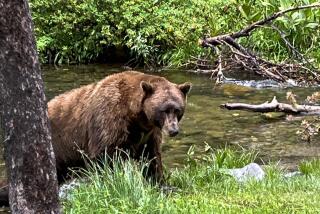Another Condor Dies in Power-Line Collision : Wildlife: Officials hasten plans to relocate sanctuary’s birds. Four have been killed in accidents.
The fourth of eight California condors released into the wild in Ventura County has died after colliding with a power line, prompting authorities to step up plans to move the remaining ones to a remote part of Santa Barbara County.
The 1 1/2-year old male suffered a broken right wing, a brain hemorrhage and liver damage after it flew into transmission lines at the Castaic Lake Recreation Area. The condor carcass was found about noon Saturday.
It was the third condor death blamed on power lines in the past year. A fourth condor died last October after ingesting antifreeze that had been dumped on the ground.
Despite a 50% mortality rate for the eight birds released in the Ventura County condor sanctuary, wildlife officials and environmentalists say the risks are part of the experimental nature of the program. Two of the condors were released in January, 1992, and six others were released in December. Seventy-one remain in captivity.
“It’s a long-term effort and we’re only at the very initial stage of this program,” said Marc Weitzel, director of the California Condor Recovery Program. “Mortality is a factor we’re going to have to deal with in the future. It’s a part of the wild population and it’s going to be part of this program.”
Elliott McClure, a retired ornithologist and member of the Conejo Valley chapter of the Audubon Society, said despite the deaths he believes the program has made progress.
“It’s a tremendously good program, and they’ve achieved a great deal,” he said. “The ones they released had to learn so much so fast. They don’t have parental guidance.”
Weitzel said the condors released near Fillmore in Ventura County have shown a stubborn tendency to leave the protected Sespe Condor Sanctuary and fly into more populated areas.
“We do tend to think that condors go through a curiosity phase where they home in on things,” he said. “Exactly how long this phase lasts, we’re not sure.”
With the discovery of the latest death, program officials on Monday hastened plans to move the remaining condors to Santa Barbara County. Beginning next week, field biologists will try to lure the birds to an open area and then trap them under a net.
Officials began trying to lure the condors north in June after a year-old female died after colliding with a power line along California 126 near Fillmore. Because trapping the birds can cause injuries, other tactics were tried first, Weitzel said.
But the methods used to lure them to Santa Barbara County--triangular-shaped kites, a helium balloon and a blimp painted with a red bull’s-eye--failed to attract the birds’ interest.
“They would fly out there but they just didn’t pay a lot of attention to them,” Weitzel said.
And calf carcasses placed northwest of the Sespe sanctuary drew the birds into the more remote area only temporarily.
In recent weeks, wildlife biologists frequently spotted two of the condors, and sometimes more, near Castaic Lake. They tried unsuccessfully to scare the birds away from the recreation area by making loud noises or shooting wads of paper at them with slingshots.
On Friday morning, two birds were settled on a perch near the lake for more than three hours and were still there at 5 p.m. Friday. But at 7:30 a.m. Saturday morning, only one bird was visible, and biologists could not pick up the radio-signal device attached to the other bird.
Wildlife officials searched the area from the Sespe Condor Sanctuary to the lake and found the bird about noon on the ground near the dam at Castaic Lake.
Weitzel said power lines are particularly hazardous to the condors.
“They’re a large bird and they’re not as agile as a smaller bird, so at night, if they’re flushed off a power line, they might turn around and fly back into it,” he said.
Once the four remaining condors are caught, they will be driven to a new condor releasing facility at Lion Canyon, which borders the San Rafael Wilderness Area in Santa Barbara County.
Five condors born this year at the Wild Animal Park in San Diego County and at the Los Angeles Zoo also will be brought to that sight in mid- to late November. They will be released after spending about three weeks in a net-and-plywood pen.
Once they are in Santa Barbara County, officials are hoping the older birds will curb their wandering habits before the younger ones are released or that the presence of the younger birds will keep the older ones in the wilderness area.
If the four condors released in Ventura County continue to roam from the wilderness area, they may be returned to captivity and used for breeding.
More to Read
Sign up for Essential California
The most important California stories and recommendations in your inbox every morning.
You may occasionally receive promotional content from the Los Angeles Times.










